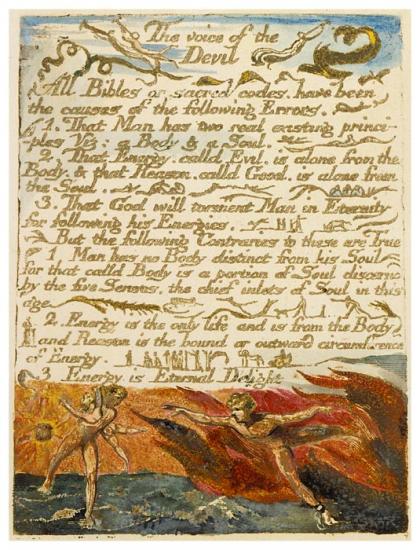A most significant key to Blake's symbolism came to light only in 1947 when Arlington Court was bequeathed to the British National Trust. Among the furnishings there was a large tempera by Blake, called alternatively The Sea of Time and Space or The Cave of the Nymphs. This treasure had been hidden from public eyes for a century.
(Most of us are unlikely to see the original, but Blake and Antiquity by Kathleen Raine offers several glimpses of the picture with a detailed account of the symbols it contains. There is no better way to begin an understanding of Blake at the deeper level than to read carefully and study this small and accessible book.)
The picture contains the essential symbolism of Blake's myth; the theme goes back to Homer, then to Plato and Porphyry. (To understand Blake's myth one would be well advised to study this link with care--at least the first part of Taylor's article.)
Blake and Taylor were approximately the same age and as young men close friends. Many people think that Taylor introduced Blake to the Platonic and Neoplatonic traditions. It seems certain that Taylor's On the Homeric Cave of the Nymphs deeply influenced the painting of the Arlington Tempera. It also introduced a great number of the most common symbols used in Blake's myth; they were used over and over throughout Blake's work.
 |
| The Morgan Library and Museum Marriage of Heaven and Hell Plate 4 |
Another good introduction to Blake's myth is The Marriage of Heaven and Hell. It comes from an angry young man pouring his scorn on the conventions that cripple us; the language is pungent, the words are pointed, provocative, and outrageous.
A conventional person will find this whole work offensive and repulsive, but the young person at the stage of life where he's ready to kick over the traces, is quickly attracted -- if he has enough wit to understand irony and not take everything at face value.
We might call it an ironic satire. In 1789 Blake was 32, at the height of his physical (though perhaps not mental) powers. He had experienced the Divine Vision.
He knew it was meant for mankind, although so far limited to Jesus and a few others. But with the advent of the French Revolution he foresaw its spread throughout the world. (Of course in that he was soon doomed to disappointment-- with the appearance of Madame Guillotine.) Nevertheless with a peak of spiritual exuberance he proceeded to announce the coming New Age:
- "The ancient tradition that the world will be consumed in fire
at the end of six thousand years is true, as I have heard from Hell.
For the cherub with his flaming sword is hereby commanded to leave
his guard at the tree of life, and when he does, the whole creation
will be consumed and appear infinite and holy whereas it now appears
finite & corrupt.... If the doors of perception were cleansed
every thing would appear to man as it is, infinite. For man has
closed himself up, till he sees all things thro' narrow chinks of his
cavern. (Plate 14 of MHH)
Pursuant to this aim:
- "How do you know but every bird that cuts the air Is an immense
world of delight, clos'd by your senses five?" (MHH, Plate 7, (E 35))
- "I then asked Ezekiel. why he eat dung, and lay so long on his
right and left side? he answered, "the desire of raising other men into a
perception of the Infinite". (E 39|
- "Man's perceptions are not bounded by organs of perception. He
percieves more than sense (tho' ever so acute) can discover." (There Is
No Natural Religion, (E 2))
"I assert for myself that I do not behold the Outward Creation and that to me it is hindrance and not Action it is as the Dirt upon my feet No part of Me.
What it will be Question'd When the Sun rises do you not see a round Disk of fire somewhat like a Guinea? O no, no, I see an Innumerable company of the Heavenly host crying Holy Holy Holy is the Lord God Almighty." (Vision of Last Judgment, (E 565))
On MHH (Plate 16) Blake tells us about the prolific (prophetic types, creative people who grasp the Eternal) and the devouring (those who worship the created good). Of course he counted himself among the prolific. John Middleton Murry has pointed out that in this moment of the everlasting 'good-and-evil' in which we live Blake may have projected the 'evil' upon the public who had uniformly ignored him. Murry suggested that it was a necessary "moment in his life".
If that be true, we have the record of the moment when Blake "came to himself" to the point where he confessed that his Selfhood continued to dominate him. He eventually came to realize that one cannot operate in the Sea of Time and Space without the Selfhood; thus he faced the necessity to continually annihilate and regenerate it with his alternation between Heaven and this vale of tears in which we live. (As Christians understand, the selfhood is brought into subjection and becomes the servant of the Self (Christ)).
In Plate 24 he promised to the world the Bible of Hell. John Middleton Murry described it as follows:
The first book of these, The Book of Urizen is to a large degree a parody of Genesis. The Book of Ahania corresponds precisely to Exodus. The third book is The Book of Los (1795).
MHH was prior to Blake's myth proper, like a preamble or preface. It defines ideas and terms that are to be understood as the myth evolves, a special language you have to learn to get into the major works - The Four Zoas, Milton and Jerusalem.
(This is a portion of Chapter Ten of the Blake Primer.).
No comments:
Post a Comment